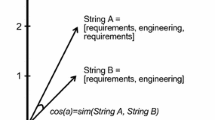Abstract
This paper presents an experiment with a linguistic support tool for consolidation of requirements sets. The experiment is designed based on the requirements management process at a large market-driven software development company that develops generic solutions to satisfy many different customers. New requirements and requests for information are continuously issued, which must be analyzed and responded to. The new requirements should first be consolidated with the old to avoid reanalysis of previously elicited requirements and to complement existing requirements with new information. In the presented experiment, a new open-source tool is evaluated in a laboratory setting. The tool uses linguistic engineering techniques to calculate similarities between requirements and presents a ranked list of suggested similar requirements, between which links may be assigned. It is hypothesized that the proposed technique for finding and linking similar requirements makes the consolidation more efficient. The results show that subjects that are given the support provided by the tool are significantly more efficient and more correct in consolidating two requirements sets, than are subjects that do not get the support. The results suggest that the proposed techniques may give valuable support and save time in an industrial requirements consolidation process.
Similar content being viewed by others
References
Brinkkemper S (2004) Requirements engineering research the industry is (and is not) wating for. In: Regnell B, Kamsties E, Gervasi V (eds), Proceedings of the 10th Anniversary International Workshop on Requirements Engineering: Foundations for Software Quality, Essen, Germany: Essener Informatik Beiträge, pp 267–284
Clements P, Northrop L (2002) Software product lines: practices and patterns. Boston, MA: Addison-Wesley
Hofmann HF, Lehner F (2001) Requirements engineering as a success factor in software projects. IEEE Software 18(4): 58–66
Juristo N, Moreno AM (2001) Basics of software engineering experimentation. Boston, MA: Kluwer Academic Publishers
Karlsson L, Dahlstedt AG, Natt och Dag J, Regnell B, Persson A (2002) Challenges in market-driven requirements engineering—an industrial interview study. In: Saliensi C, Regnell B, Pohl K, (eds), Proceedings of the Eigth International Workshop on Requirements Engineering: Foundation for Software Quality, Essen, Germany: Essener Informatik Beiträge, pp. 37–49
Kotler P (2002) Marketing management. Upper Saddle River, NJ: Prentice Hall
Krueger CW (2003) Towards a taxonomy for software product lines. In: Proceedings of the 5th International Workshop on Product Family Engineering, Siena, Italy
Lauesen S (2002) Software requirements: styles and techniques. London, UK: Addison-Wasley
Lubars M, Potts C, Richter C (1993) A Review of the state of the practice in requirements modeling. In: Proceedings of IEEE International Symposium on Requirements Engineering, Los Alamitos, CA: IEEE CS, pp 2–14
Mich L, Franch M, Novi Inverardi PL (2004) Market research for requirements analysis using linguistic tools. Requirements Engineering 9(1): 40–56
Montgomery DC (2001) Design and analysis of experiments. USA: John Wiley & Sons
Natt och Dag J, Gervasi V (2005) Managing large repositories of natural language requirements. In: Aurum A, Wohlin C (eds) Engineering and Managing Software Requirements, Springer-Verlag
Natt och Dag J, Regnell B, Carlshamre P, Anderssonm M, Karlsson J (2002) A feasibility study of automated natural language requirements analysis in market-driven development. Requirements Engineering 7(1): 20–33
Natt och Dag J, Gervasi V, Brinkkemper S, Regnell R (2004) Speeding up requirements management in a product software company: linking customer whishes to product requirements through linguistic engineering. In: Proceedings of the International Requirements Engineering Conference (RE2004), Kyoto, Japan: IEEE CS, pp 283–294
Natt och Dag J, Gervasi V, Brinkkemper S, Regnell B (2005) A linguistic-engineering approach to large-scale requirements management. IEEE Software 22(1): 32–39
Novorita RJ, Grube G (1996) Benefits of structured requirements methods for market-based enterprises. In: Proceedings of the Sixth Annual International Symposium on Systems Engineering (INCOSE'96), Boston, MA
Potts, C. 1995. Invented requirements and imagined customers: requirements engineering for Off-The-Shelf Software. In: Proceedings of the Second IEEE International Symposium on Requirements Engineering, Los Alamitos, CA: IEEE CS pp 128–130
Regnell B, Beremark P, Eklundh O (1998) A market-driven requirements engineering process—results from an industrial process improvement programme. Journal of Requirements Engineering 3(2): 121–129
Sawyer P, Sommerville I, Kotonya G (1999) Improving market-driven RE Processes. In: Proceedings of International Conference on Product Focused Software Process Improvement (PROFES'99), Jun, Oulu, Finland, pp. 222–236
Sommerville I (2001) Software Engineering. 6th edition. Harlow, UK: Pearson Education
Wohlin C., Runeson P, Höst M, Ohlsson MC, Regnell B, Wesslén A (2000) Experimentation in software engineering—an introduction. Norwell, MA: Kluwer
Yeh A (1992) Requirements engineering support technique (REQUEST)—a market driven requirements management process. In: Proceedings of the Second Symposium on Assessment of Quality Software Development Tools, Los Alamitos, CA: IEEE CS, pp 211–223
Author information
Authors and Affiliations
Corresponding author
Rights and permissions
About this article
Cite this article
Natt och Dag, J., Thelin, T. & Regnell, B. An experiment on linguistic tool support for consolidation of requirements from multiple sources in market-driven product development. Empir Software Eng 11, 303–329 (2006). https://doi.org/10.1007/s10664-006-6405-5
Published:
Issue Date:
DOI: https://doi.org/10.1007/s10664-006-6405-5




